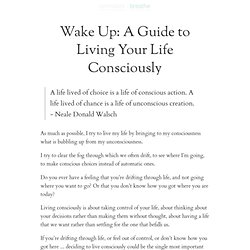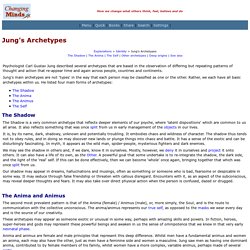

Brain & Mind Tools. Wake Up: A Guide to Living Your Life Consciously. A life lived of choice is a life of conscious action.

A life lived of chance is a life of unconscious creation. - Neale Donald Walsch As much as possible, I try to live my life by bringing to my consciousness what is bubbling up from my unconsciousness. I try to clear the fog through which we often drift, to see where I’m going, to make conscious choices instead of automatic ones. Do you ever have a feeling that you’re drifting through life, and not going where you want to go? Or that you don’t know how you got where you are today? Living consciously is about taking control of your life, about thinking about your decisions rather than making them without thought, about having a life that we want rather than settling for the one that befalls us. If you’re drifting through life, or feel out of control, or don’t know how you got here … deciding to live consciously could be the single most important thing you do.
Are you living unconsciously now? 1. 2. 3. 4. 5. 6. 7. 8. 1. 2. 3. 4. 5. For more. Jung's Archetypes. Explanations > Identity > Jung's Archetypes The Shadow | The Anima | The Self | Other archetypes | Deep origins | See also Psychologist Carl Gustav Jung described several archetypes that are based in the observation of differing but repeating patterns of thought and action that re-appear time and again across people, countries and continents.

Jung's main archetypes are not 'types' in the way that each person may be classified as one or the other. Rather, we each have all basic archetypes within us. He listed four main forms of archetypes: The Shadow The Shadow is a very common archetype that reflects deeper elements of our psyche, where 'latent dispositions' which are common to us all arise. It is, by its name, dark, shadowy, unknown and potentially troubling. We may see the shadow in others and, if we dare, know it in ourselves. Our shadow may appear in dreams, hallucinations and musings, often as something or someone who is bad, fearsome or despicable in some way.
The Anima and Animus. Three registers of human reality. Disciplines > Psychoanalysis > Concepts > Three Registers of Human Reality Description | Discussion | See also Description Lacan described what he called 'three registers of human reality', whereby we perceive and understand.

The Real The 'real' is a world which we never actually perceive. Living in the real is almost animalistic in that it is dominated by need and satisfaction, existing before the constraints of language, mental models and cultural codes that censor such basic mores. We get as close to the 'real' as possible during the neonatal phase, when we are pre-mirror and pre-symbolic, but we never really know it fully. Because we cannot fully know the real, we always have a sense of lack, of something missing or wrong. The Imaginary The imaginary is not so much about 'imagination' as 'images'.
The imagination can be used to help fill in the void that is created by the inaccessible real by making images of completeness. When we think in images, we do not need words. The Symbolic See also.